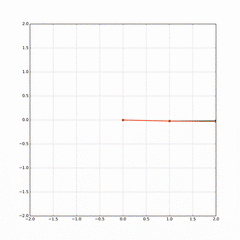How it Works
The Swinging Stick
The sculpture is a seemingly simple structure, which arouses people’s curiosity about its design principles. The kinetic sculpture is carefully hand-made by very experienced craftsmen, who will precisely calibrate the weights and magnets in the arms to achieve endless, unpredictable movements. Although it seems easy to make, in fact, a high-level of knowledge in science, mathematics, and physics is essential to understand how it is made and works.
So where did the idea of ”The Swinging Sticks” come from?
The concept of this kinetic sculpture can be traced back to the concept of perpetual motion, which is a theory put forward by many scientific and philosophical thinkers for a century.

Perpetual Motion Device
The history of perpetual motion machines idea dates back to the Middle Ages and were first documented in (c.1159). A perpetual motion machines were described by the Indian author Bhaskara. One was a wheel with containers of mercury around its rim. As the wheel turned, the mercury was supposed to move within the containers in such a way that the wheel would always be heavier on one side of the axle.
Villard de Honnecourt was born in the late 12th century and lived in France from 1225 to 1250. His sketchbook with 250 drawings has survived, and now is in the Bibliothèque Nationale in Paris. The most celebrated of his machine designs was for a perpetual motion wheel. It was an overbalanced wheel with hinged hammers or mallets equally spaced around its rim.
One of the famous known inventors of perpetual motion experiments was Leonardo Da Vinci, who studied this concept in depth and tried to build many different models. In the end, Da Vinci concluded that perpetual motion machines were impossible, so he gave up the idea. Although Da Vinci abandoned perpetual motion machines, many physicists and engineers are still trying to design perpetual motion machines.
If it proves to be true, we will see that things like endless motors do not require energy because they will not be affected by friction and gravity. However, in the world we live in, friction and gravity is a very real concept. Therefore, according to our modern understanding of physics, friction and gravity will prevent anything from realizing a true perpetual motion machine.


Physics
The Swinging Sticks sculpture works by imitating permanent motion devices. It’s an illusion, since it is driven by electric current and electromagnetic fields. Current physics believes that modern technology cannot achieve a true perpetual motion machine. However, one of the key principles in physics also points out that moving electrons generate magnetic fields.
The generated magnetic field is the driving force of the entire sculpture. The Swinging Sticks contain measuring sensors that can perform various functions. Two of the sensors are used to measure the speed of the rotating rod. The middle electric coil is used to adjust the speed, making it faster or slower, according to the speed judged by the 2 sensors.
The arm of the Swinging Sticks has a powerful neodymium magnet built in. When these magnets pass through the magnetic field generated by the electric coil, they will be repelled and “assist” the unpredictable “chaos” motion.
As long as the magnetic field is generated, the process will be repeated. The position of the magnet, Coil and Distance in addition to the weights must be extremely precise to avoid wasting movement or power.
The Swinging Sticks- ORIGINAL contains highend and long lasting C1 bearings and special electrical components to reduce energy consumption.
In physics and mathematics, in the area of dynamical systems, a double pendulum is a pendulum with another pendulum attached to its end, and is a simple physical system that exhibits rich dynamic behavior with a strong sensitivity to initial conditions. The motion of a double pendulum is governed by a set of coupled ordinary differential equations and is chaotic.
As long as there is a battery (alkaline preferrable), the sculpture will run forever and continuously rotate in the electromagnetic field generated. The Swinging Sticks – ORIGINAL can to run for a long period of time (up to 2 years) without the need to replace batteries, due to the quality of the parts
in the sculpture.


Mathematic
The Swing Sticks obey a series of calculus equations in physics related to double pendulums. This requires an understanding of differential equations, which is a very advanced area in mathematics. A double pendulum is a pendulum attached to the end of an item. The Swing Sticks are a simple or compound double pendulum because they only operate in a 2D plain.
For the most part, the movement feels messy although there is a sporty beauty behind the swing sticks. The Swing-Stick equations for twin pendulums were solved using Runge-Kutta methods for numerical analysis. This technique was developed in the early twentieth century by mathematicians C Runge and M.W. Kota.



